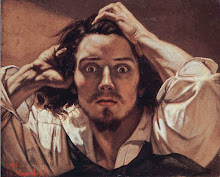 Painting by Victor Oliva, from Wikipedia.
Painting by Victor Oliva, from Wikipedia. Yesterday, I had two glasses of absinthe. I was going to order tequila but when I saw the absinthe (made in the Czech Republic), I had to try it. After reading the decadent turn-of-the-century artists and poets as a kid, I was curious. The stuff was supposed to be hallucinogenic and therefore banned along with so many other drugs at the turn of the century.
I was ready for an experience like the one Viktor Oliva portrayed, above. No such luck, as always. But the Wikipedia remark, "The most commonly reported experience is a "clear-headed" feeling of inebriation — a form of 'lucid drunkenness'"(See below) is accurate. The feeling lasted only a few moments, however.
Below, the Czech absinthe:
 From Wikipedia
From WikipediaThe banning of absinthe
Spurred by the temperance movement and the winemakers’ associations, absinthe was publicly associated with violent crimes and social disorder.
A critic said that:[23]
“ Absinthe makes you crazy and criminal, provokes epilepsy and tuberculosis, and has killed thousands of French people. It makes a ferocious beast of man, a martyr of woman, and a degenerate of the infant, it disorganizes and ruins the family and menaces the future of the country. ”
Edgar Degas’ 1876 painting L’Absinthe, which can be seen at the Musée d’Orsay, epitomized the popular view of absinthe addicts as sodden and benumbed. Although Émile Zola mentioned absinthe only once by name, he described its effects in his novel L’Assommoir:[24]
“ Boche had known a joiner who had stripped himself stark naked in the rue Saint-Martin and died doing the polka — he was an absinthe-drinker. ”
In 1905, it was reported that Jean Lanfray murdered his family and tried to kill himself after drinking absinthe. The fact that Lanfray was an alcoholic who had consumed much more than his usual two glasses of absinthe in the morning, was overlooked; the murders were blamed solely on absinthe.[25] The murders were the last straw, and a petition to ban absinthe in Switzerland was subsequently signed by more than 82,000 people. The prohibition of absinthe was then written into the Swiss constitution in 1907.
Effects of absinthe
Absinthe has been frequently and incorrectly described in modern times as being hallucinogenic. In the 1970s, a scientific paper mistakenly reported thujone was related to THC, the active chemical in cannabis.
Ten years after his 19th century experiments with wormwood oil, Magnan studied 250 cases of alcoholism and claimed that those who drank absinthe were worse off than those drinking ordinary alcohol, and that they experienced rapid-onset hallucinations. Such accounts by absinthe opponents were embraced by its most famous users, many of whom were bohemian artists or writers.
Two famous painters who helped popularize the notion that absinthe had powerful psychoactive properties were Toulouse Lautrec and Vincent van Gogh, the latter having suffered from mental instability throughout his life. In one of the best known accounts of absinthe drinking, Oscar Wilde described the feeling of having tulips on his legs after leaving a bar.
Today it is known that absinthe does not cause hallucinations. Thujone, the active chemical in absinthe, is a GABA antagonist; and while it can produce muscle spasms in large doses, there is no evidence that it causes hallucinations.[62] It has been speculated that reports of hallucinogenic effects of absinthe may have been due to poisonous chemicals being added to cheaper versions of the drink in the 19th century, to give it a more vivid color.
However, the debate over whether absinthe produces effects on the human mind additional to those of alcohol has not been conclusively resolved. The effects of absinthe have been described by some as mind opening. The most commonly reported experience is a "clear-headed" feeling of inebriation — a form of "lucid drunkenness". Chemist, historian and absinthe distiller Ted Breaux has claimed that the alleged secondary effects of absinthe may be caused by the fact that some of the herbal compounds in the drink act as stimulants, while others act as sedatives, creating an overall lucid effect of awakening.
Long term effects of low absinthe consumption in humans remain unknown, although the herbs in absinthe have both painkilling and antiparasitic properties.

No hay comentarios.:
Publicar un comentario